 9
9 
 9
9 
A lot of the food we eat is alive. Fresh, uncooked fruits and vegetables are made of cells that are still living and breathing long after they are picked. But cheese, yogurt, wine, beer, pickles, sauerkraut, olives, and many other foods are produced by the action of living microbes. In many of the foods we eat, these microbes are still alive, doing their job.
If you think for a moment about how difficult it is to keep something sterile, you will realize that just about everything has something living in it or on it. Most bacteria are benign, as are most yeasts, and there may be more beneficial varieties than there are harmful ones.
The yeasts and bacteria in a sourdough starter come from the flour used to make the starter (very little yeast is actually floating in the air). Bees carry yeasts from flower to flower, where they feed on the nectar. When the fruit sets, the yeasts grow in the skin of the fruit, where sugars and moisture are available. The powdery coating on grapes is yeast. Crushing the grapes allows the yeast to mix with the juices and ferment them into wine. No added yeast is actually necessary, but it is usually added to overwhelm any natural yeasts and produce a consistent product.
In most foods that are produced or modified by microorganisms, the environment is adjusted to suit the desired organisms and to make undesirable organisms have a harder time. In pickles, for example, salt is added to allow bacteria that produce lactic acid to outcompete harmful varieties that compete for the sugars in the cucumber. The bacteria then help out further by making the environment too acidic for other life-forms. Too much salt, however, allows harmful yeasts to grow, which then eat the lactic acid and thus invite even more undesirable microbes to grow.
Controlling other factors in the environment, such as temperature, moisture, and oxygen, also help select for the desirable organisms in the food you are producing.
For thousands of years, people made bread with yeast, not realizing that they were farming microorganisms. That a living thing was responsible for the rising of bread was only recognized after the invention of the microscope.
Under a microscope, yeasts appear as single cells, like bacteria. Unlike bacteria, however, yeast reproduces by growing smaller yeast cells as buds on the parent cell. In some varieties of yeast, the buds do not detach, and long strings of cells form as the new buds grow to full size and then bud new yeast cells.
The yeasts used in bread, beer, and wine eat sugar. There is little sugar in flour, but uncooked flour has enzymes that break down the starch molecules in the flour into small sugar molecules that the yeast can feed on. The enzymes start to work as soon as water is added to the flour.
In wine, the sugars of the grape feed the yeast. In beer, some of the grain is allowed to sprout, and the sprouting seedling produces large amounts of the enzymes that convert starch into sugars. The sprouts are ground and added to the other grains in the vat, and the yeast feeds on the sugars that are produced by the action of the enzymes.
As the yeast feeds on the sugars, two waste products are excreted. One is alcohol, and the other is carbon dioxide. In beer, both are desirable. In wine, the carbon dioxide is often allowed to escape into the air before the wine is bottled. When a carbonated product is desired, extra sugar is often added just before corking the bottle so the yeast that remains can produce more of the gas.
In bread, it is the carbon dioxide that bakers are after. Alcohol is still produced, and a measurable amount of alcohol remains in the bread even after an hour of cooking at high temperature. This alcohol may help to dissolve aromatic molecules and enhance the scent and flavor of the bread, but generally you are only concerned with the amount of gas the yeast produces to make the dough into a nice light foam.
In modern bread recipes, commercially grown yeast is generally used. The large amount of yeast that is added to the dough ensures that this one strain of yeast outcompetes all other organisms in the dough, so that uncontrolled bacteria or wild yeast does not affect the flavor of the bread.
Yeast also produces enzymes such as transglutaminase that change the behavior of the gluten in the dough. The dough becomes less extensible as more of the enzyme is produced and more cross-linking occurs in the glutenin proteins. This strengthens the dough.
Yeast lives on small sugars such as glucose, sucrose, and maltose. The wheat kernel contains enzymes that break down the starch (its stored energy source) into maltose and glucose, which can then be used directly by the growing wheat sprout. Grinding the kernel into flour and wetting the flour allows the enzyme to break down the starch, so the yeast has a food supply.
The yeast has its own enzymes, among them maltase, which breaks down maltose into two glucose molecules. As the yeast feeds on the glucose, it produces not only carbon dioxide and alcohol but also many other molecules (aldehydes, ketones, aromatic heavy alcohols, and other metabolic byproducts) that add flavor to bread, beer, and wine.
Stir some water into flour and let it sit for a day. The microbes in the flour will begin to grow. Feed it more flour and water every day, and after a week the ecology in your jar will stabilize, with a mix of yeasts and bacteria that is called sourdough starter.
In practice, feeding a starter involves throwing half of it away when you add more flour and water. There is not very much food in flour that the microbes can actually eat, so throwing away the “used up” part of the mixture keeps it from diluting the new food with what the microbes consider waste matter.
After a week has gone by, and you have a nice stable culture, you no longer waste any starter. Instead, you can make bread with it and feed some of the resulting bread dough back to the starter jar.
Regular baker’s yeast will not survive long in the acid environment of a sourdough starter. The variety of wild yeasts that come to live in harmony with the acid-making bacteria in the culture are of a different type, such as Candida milleri, Candida krusei, Pichia saitoi, and Saccharomyces exiguus. Along with these acid-tolerant yeasts grow acid-producing bacteria such as Lacto-bacillus sanfranciscensis, a species originally found in sourdough starter from San Francisco but later found to be in many sourdough starters all over the world.
The bacteria are smaller than the yeasts, and outnumber them 100 to 1 in most sourdough cultures. Candida milleri yeast can’t eat the sugar maltose, but the bacteria can. In this way, they can coexist without competing with one another too much, even though both will eat glucose. The bacteria produce lactic and acetic acids and another antibiotic called cycloheximide that kill off many of the competing and potentially harmful organisms but leave the symbiotic yeasts and bacteria unharmed.
The bacteria also excrete glucose as they metabolize maltose, making the glucose available to the yeasts. Maltose is made of two glucose molecules bound together, and when the bacteria break them apart, some of the glucose escapes into the culture medium.
There are many different species and strains (varieties within a species) of bacteria besides Lactobacillus sanfranciscensis. Other lactobacillus species often found in starter cultures are plantarum, pentosus, rossi, pontis, acidophilus, delbrueckii, homohiochii, hilgardii, viridescens, panis, pastorianus, oris, vaginalis, reuteri, buchneri, fructivorans, salivarius, brevis, fermentum, casei, and paraplantarum. When present in bread, these bacteria act to inhibit mold and thus serve as preservatives.
The bacteria require more than just sugars to survive, and what they don’t get from the flour they get from dead yeast cells. So each of the symbionts in the partnership produce something the other needs.
Of course there are many other yeasts and bacteria growing in the culture in smaller numbers. Some grow there despite the nonoptimal growing conditions of acidity and antibiotic substances produced by the main colonists in the culture.
A cook might want to control the growth of each of the two types of microorganism. The bacteria provide flavors that the cook might want to make more robust or more subtle, and the yeast provides the main source of carbon dioxide to make the bread lighter in texture. Knowing the best growing conditions for each type of microbe allows the cook to trade off one in favor of the other.
Candida milleri (the yeast) is tolerant of a wide range of acidity. The bacteria (Lactobacillus sanfranciscensis) grow best at a pH of 5.5, and don’t grow as well below 4.5 or above 6.5. Adding vinegar or baking soda to the starter can select against the bacteria while allowing the yeast to grow (the cook would want to actually measure the pH to make sure it was in the desired range). The bacteria generally grow faster than the yeast at pH levels above 4.5.
The bacteria grow fastest at a temperature of about 90°F (32°C), while the yeast grows fastest at about 80°F (27°C). Since the yeast produces undesirable flavors when growing rapidly, a temperature above or below the optimum for speed of growth is considered best for bread flavor. So, if the cook wants to encourage the bacteria, a temperature of 90°F might be worth a try, and if the yeast is to be encouraged instead, a temperature of 70°F to 75°F (21°C to 24°C) might be sought. It might even be interesting to grow the starter at 90°F to get the flavors from the bacteria, and then “proof” the actual bread dough at 75°F to grow the yeast for faster rise times. The starter might be left to grow for a day unattended, but the waiting for the bread to rise might be less convenient.
The yeast is more tolerant of salt than the bacteria. The yeast will grow in salt up to a concentration of 8 percent, but the bacteria die out at 4 percent. Using that much salt in a bread recipe would not be advised, but since the starter will be diluted 5 or 6 to 1, this might be a place where experimentation can be done. Adding small amounts of salt has been shown to stimulate yeast growth in sourdoughs, possibly by eliminating some competition from the bacteria for nutrients they both require.
The yeast grows less as the alcohol content rises, but the bacteria are for the most part unaffected until the alcohol rises to 6 percent (the growth falls off sharply to zero in both organisms at 8 percent).
The yeast is strongly affected by acetic acid (which the bacteria produce from lactic acid in anaerobic conditions), while the bacteria are more tolerant. Both are fairly tolerant of lactic acid.
The reason these two organisms grow well in symbiosis is that they have very similar growth response at temperatures between 68°F and 82°F (20°C and 28°C) and pH levels around 4 or 5. When growing a sourdough starter (especially a new one), keeping the conditions in this range will select for a stable symbiotic mix and select against harmful organisms. Once the starter is well established, short-term deviations from these conditions to promote one type over the other can be successful.
When bacteria like Enterococcus faecalis and Pediococcus pentosaceus colonize a starter, some proteolytic (protein breaking) enzymes are produced. These harm the dough by breaking down the gluten needed to trap the gas bubbles. The lactobacillus bacteria do this as well, but to a much lesser extent. Nonetheless, selected strains of lactobacillus have been used to break down the gluten in wheat flours to make it palatable to people with celiac disease, a condition where the immune system is activated by gluten and attacks the lining of the intestine.
The breakup of the gluten protein is not completely harmful to the dough, however. Some of the breakdown products are important to the flavor and aroma of sourdough bread, and as the bacteria break down the protein to free the nitrogen they need for food, they convert some of it into essential amino acids normally missing from wheat flour, such as lysine. They thus improve the nutritional value of the bread to a small extent.
Adding Lactobacillus acidophilus bacteria to warm milk makes yogurt. The bacteria eat the sugar lactose in the milk and produce lactic acid. The lactic acid denatures the casein proteins in the milk, allowing them to unwind and bind together, forming a gel.
The bacteria compete with harmful bacteria that would otherwise cause the milk to spoil. The acidity of the yogurt prevents some of the harmful organisms from growing well enough to be a problem.
Raw milk can harbor a number of dangerous microbes, the most common of which are Staphylococcus aureus, Campylobacter jejuni, salmonella, Escherichia coli, Listeria monocytogenes, Mycobacterium tuberculosis, Mycobacterium bovis, brucella, Coxiella burnetii, and Yersinia enterocolitica.
Staphylococcus aureus grows best at neutral pH (7.0 to 7.5) but can survive in milk as acid as 4.5 pH. The pH of yogurt is just below that level (4.25 to 4.5). Likewise, salmonella, Campylobacter jejuni, Escherichia coli, Listeria monocytogenes, and Mycobacterium tuberculosis all grow poorly or not at all at pH levels more acidic than 4.5. Note, however, that these are not all of the dangerous organisms that can be found in raw milk, and pasteurization is a far better protective mechanism than culturing lactobacillus.
Lactobacillus is not the only bacterium used to sour dairy products. Both buttermilk and sour cream contain Streptococcus diacetilactis, Streptococcus lactis, Streptococcus cremoris, and Leuconostoc citrovorum, along with other less common bacteria.
Both buttermilk and sour cream keep for weeks in the refrigerator and are easy to make at home. If you have a container of milk that is getting old (but has not already turned sour), you can turn it into buttermilk for baking instead of waiting for it to sour and throwing it away.
The starter culture for buttermilk is some leftover buttermilk, since all of the necessary bacteria are already in the leftovers.
Make sure you have a very clean one-quart container. Put a cup of cultured buttermilk that has not passed its “use by” date (since you want the bacteria to be alive) into the container and fill it up with the milk. If making more or less, keep the 1-cup-to-3-cups ratio for best results.
Cover the container tightly and leave in a warm place for 24 hours. It should have thickened in that time, but if not, you can leave it for up to 36 hours before it no longer tastes good enough to drink (it is still good for baking, however).
The liquid left over from making butter is not the same as cultured buttermilk. It is not thick, and it often has flakes of butter in it. In the United States it is referred to as “old-fashioned buttermilk.” Some cultured buttermilk has bits of butter added to mimic old-fashioned buttermilk. But only true cultured buttermilk will work well as a starter for the buttermilk you need in baking, or for buttermilk pancakes.
Making your own sour cream is as easy as making your own buttermilk. Add a small amount of buttermilk to some cream and let it sit in a warm place for a day. The higher the fat content of the cream, the thicker the sour cream will be.
When Alexander Fleming discovered penicillin on September 3, 1928, it may have been more than just his untidy laboratory that deserved the credit. It may have been his lunch.
He had been studying staphylococci, a disease-causing bacteria, and had stacked his cultures in a corner of his lab when he went on vacation for the month of August. On returning September 3, he noticed that one culture was contaminated with a fungus and that the bacteria around the fungus had been killed.
It took another 10 years before chemists at Oxford were able to produce a stable form of the antibiotic from the fungus, and 5 more years before industrial methods were developed to produce it in usable quantities.
But penicillium molds had been used as antibiotics since ancient times, long before bacteria were known to be the cause of many diseases. In 1870, it was noted that cultures with mold in them would not produce bacteria. John Tyndall demonstrated to the Royal Society in 1875 that penicillium fungus had antibacterial properties. In 1877 Louis Pasteur observed that anthrax was inhibited in cultures that had been contaminated by molds. In 1897 Ernest Duchesne (using a different species of penicillium than that used to make penicillin) cured guinea pigs of typhoid.
Fleming isolated Penicillium notatum as the species that produced the antibiotic, and later work identified strains of that species that produced even more of the substance. Duchesne used Penicillium glaucum, the species used to make Gorgonzola cheese. That species, along with Penicillium roqueforti, is also used to make bleu, Roquefort, and Stilton cheeses.
Penicillium is a common bread mold, and it is the main cause of spoilage in stored grains. Like many of the other organisms we have been discussing, it produces chemicals that inhibit or kill competing organisms. Unlike the alcohol or lactic acids produced by yeasts and bacteria in wine and yogurt, the chemicals produced by the mold are not a waste product that has side benefits, but has evolved because it gives the mold a strong advantage in competing for food.
In cheese, it not only provides the characteristic flavor and aroma of bleu cheese, but it also protects the cheese from spoilage from more harmful bacteria and fungi that would either produce undesirable flavors and odors or produce toxins that would make the food unfit for consumption.
Alexander Fleming was studying staphylococcus cultures to find something that would kill them, so his rediscovery of the benefits of the mold came when he was well prepared to make use of the information. But it may have been the bread or cheese from his lunch, left in the lab for a month while he was on vacation, that should actually get the credit. We’ll never know.
Roquefort cheese contains the highest levels of glutamates of any naturally produced food. Glutamates are what give savory, protein-rich foods their taste, and they are found in other fermented foods, such as soy sauce. Purified as monosodium glutamate and used as a flavor enhancer, it is sometimes overused, and people with a sensitivity to it complain. But it is found in almost all foods that contain protein, and our tongues have specialized sensors for it to help us find nutritious, protein-rich additions to our diet.
You can make your own cheese fairly easily these days, thanks to the availability of rennet tablets in the supermarket. Adding a little bit of bleu cheese or Roquefort to the curds before pressing the cheese can be a tasty way to experiment with microbial processing and the use of antibiotics to preserve foods.
Yeast is on the outside of grapes and grains such as barley, wheat, and rice. So it is no surprise that grape juice or wet grains eventually ferment. Beer and wine have been around since before agriculture, for more reasons than just to provide a head buzz.
As with other foods made with microorganisms, creating a friendly environment for one organism can make that same environment less friendly to other, potentially harmful organisms. The alcohol that yeast produces helps to preserve the wine and beer, so those calories and nutrients can be saved for a day when food is less available.
As people began to live in more concentrated populations, the lack of sanitary drinking water became a problem. Septic systems and sewage treatment plants were not available, and the local water supply was not always fit to drink. But wine and beer, even with low alcohol content, were generally safe to drink. Either the water came from the grape or it was boiled with the grains. In either case the germs that cause typhus, diphtheria, dysentery, and other water-borne diseases were not present.
There are between 700 and 900 calories in a liter of wine, and 360 or so in a liter of beer. So besides being safer to drink than the local water, they provided energy and some amount of nutrition.
Beer has been called “liquid bread” because it is made of grains and yeast. Weak beers with low alcohol content could be consumed without compromising mental faculties or losing bodily fluids from the diuretic effects of alcohol.
Making beer and wine is simple. Making good beer or wine is an art. Like most of the foods made with microorganisms, much of the work is involved with making sure you encourage the organisms you want and discourage those you don’t want.
Sterilization helps, so that there are no harmful organisms to start out. Controlling the temperature also helps to make a consistent brew. Paying attention to the nutrient requirements of the desired organism, and limiting the nutrition of the undesired ones, will help to keep the ecology of the brew in balance. Controlling the mineral content of the water used (in the case of beer) affects both the taste of the resulting beer and the health and vigor of the yeasts that make it. Making sure the brew gets enough oxygen helps to keep the yeast healthy and to prevent harmful anaerobic bacteria from growing. Brewers carefully control when aeration occurs. The yeast multiplies when there is enough oxygen, and it produces alcohol and carbon dioxide when there is less. Aeration when the temperature is too high causes bad flavors to develop.
Controlling the temperature helps to promote yeast growth and inhibit bacterial growth. The wort—the liquid that becomes beer after fermentation—is boiled but then quickly cooled, since undesired bacteria grow well at temperatures between 130°F and 90°F (54°C and 32°C). Aeration is begun when the temperature is below 80°F (26°C) to prevent oxidation while still providing oxygen for the yeast to multiply. Rapid cooling also prevents sulfur-containing compounds from redissolving in the wort, causing a cooked cabbage taste.
In beer making, there are two main types of yeast: top fermenting and bottom fermenting. Top-fermenting yeasts, called ale yeasts, prefer warmer temperatures; they go dormant below about 55°F (12°C). Bottom-fermenting yeasts, called lager yeasts, stay active down to about 40°F (4°C). While lagers are usually brewed at lower temperatures than ales, steam beer uses lager yeasts at the higher temperatures to get a different flavor.
To keep foreign organisms out of the beer as it ferments, the gas is allowed to escape through a tube to bubble up through water. This is called an air lock.
As with other foods produced by microorganisms, it helps to start with a large number of the desired organisms to overwhelm any of the undesirable ones. In the case of beer and wine, yeast is often added rather than relying on the natural yeast on the grapes or on the grain.
Brewers use a device called a hydrometer to measure the density of the liquid. This indicates how much sugar is dissolved in the wort, and thus how the fermentation is progressing (as the yeast consumes the sugar and produces less dense alcohol).
To make sparkling wine or control the carbonation in beer, sugar is sometimes added just before bottling. This allows the small amount of remaining yeast to produce carbon dioxide, which cannot escape the bottle. The pressure rises and the gas dissolves in the water.
Many of the processed foods we enjoy were invented as ways of preserving fresh foods for consumption later. Dried fruits, cheese, salted meats, fermented beverages, yogurt, pickles—all are ways of extending the useful storage time of fresh fruits, grains, meats, and dairy products.
Life needs water to survive and grow. Eliminating water prevents harmful organisms from consuming the food and spoiling it. Many fresh fruits and meats can be simply dried in the sun to preserve them. Fresh-cut grass is dried to store as livestock feed.
Salting food is another way of preventing harmful organisms from getting the water they need to survive and thrive. If the outside environment is saltier than the inside of an organism, the water diffuses out to dilute the salt. The organism dries out, even if there is lots of salty water outside.
Meat and fish are salted more than fruits because the sugar in the fruit has the same osmotic effect on harmful organisms as salt does, once the fruit has dried enough to concentrate the sugar a bit. Fish and meats spoil quickly in the sun without some salt to prevent bacteria, molds, and yeasts from getting a foothold before the drying has progressed enough to preserve the food.
Another way to prevent organisms from getting started is to keep the temperature high enough to kill them or prevent growth. This can be done while drying the food, or in the case of canning, it can be done while the container is sealed to prevent organisms from getting into the packaging after the food has been sterilized.
Smoking preserves food by heating, drying, and sealing the outside of the food with substances that do not promote the growth of spoilage organisms. Smoking foods also controls oxidation to some extent, which is another way that food becomes spoiled. The smoke itself is only a coating; it does not penetrate very far into the food.
You have seen how alcohol preserves grains and fruit juices when they are fermented, but alcohol is also sometimes used to preserve other foods. In brandied fruit, alcohol is added to chopped fruits that are then allowed to ferment. The alcohol prevents bacteria from competing with the fermentation yeasts in the early stages of the process. Once the process has been started, new fruit can be added as the brandied fruit is eaten, without needing to add extra alcohol. In this way, the original brandied fruit acts like the starter used in making sourdough bread.
It is no accident that the use of spices in food correlates with the average temperature of the region from which the recipe is derived. Temperatures that promote the growth of bacterial and fungal spoilage organisms are prevalent in the countries where foods are heavily spiced.
The essential oils in sage, mint, hyssop, and chamomile have bacteriostatic effects—they prevent bacteria from growing—on Gram-negative bacteria such as E. coli and Gram-positive bacteria such as Listeria innocua. The essential oils from oregano have bactericidal (the bacteria are actually killed) effects that are most pronounced on Gram-negative bacteria.
Strong antimicrobial activity is found in cinnamon, cloves, and mustard. Less pronounced effects in allspice, bay leaf, caraway, coriander, cumin, thyme, and rosemary are similar to those of sage and oregano. Black pepper, red pepper, and ginger have only weak activity.
Garlic and onion are effective against salmonella, E. coli, staphylococcus, and Candida albicans.
Cinnamon, cloves, and sage all contain eugenol, an effective antimicrobial and mold inhibitor that is used in mouthwashes and baked goods.
Sage and oregano contain thymol, another effective antimicrobial, often used in toothpastes.
The oleoresins in rosemary also act as antioxidants and prevent rancidity of fats and oils in foods.
You have seen how making foods more acidic helps to preserve them, as in the case of yogurt and sourdough bread. But raising the acidity much higher—by pickling foods in vinegar—is an ancient and effective way of preserving foods from olives and cucumbers to boiled eggs and herring.
Besides yogurt and sourdough bread, other foods are pickled by fermentation that produces lactic acid. The most recognizable is probably pickled cucumbers or peppers. But sauerkraut and kimchi are also fermented in this way, after adding salt to make a brine.
Friendly microbes are also used to help fight harmful ones. Some produce toxic chemicals such as alcohol or lactic acid, but others produce more targeted antibacterial agents. The penicillin molds in some cheeses kill bacteria. Bacteria in other cheeses produce propionates that kill molds and fungi.
As you have seen before in several foods, controlling the environment to favor the organisms we like helps to limit the growth of the organisms we wish to avoid.
 Recipe
RecipeToward the end of October you’ll start seeing lots of recipes for pumpkin this and pumpkin that. This one is different. It involves liquor and a blender, but it is something I recommend you do with kids. It takes very little time to make, but your kid might want to take it to school for her science fair project. That said, you probably won’t want to eat it But it’s fun.
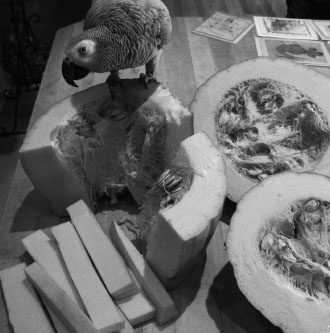
You’re going to extract the DNA—the very stuff of life—from a pumpkin.
Supplies:
For the high-percentage alcohol, you can use rubbing alcohol, which is about 70 percent, or you can get 91 percent isopropanol at some drugstores—that’s what I normally use. But you might already have some 151-proof rum or some Everclear grain alcohol close to the kitchen. Not being a drinker, I had to go out and buy some for the photos. (Someday I’ll cook up something that needs to be set on fire to use up the remainder of the bottle.) Put the alcohol in your freezer right away. You will want it as cold as you can get it for the experiment. Don’t worry, it won’t freeze—you can keep it in the freezer overnight or forever. But an hour in the freezer will probably do fine.
Cut a pumpkin into small chunks that fit in the blender. My assistant, Corky, helps me with all my Halloween projects. He also likes to eat raw pumpkin, something your helper might not find so tasty. Have your assistant place the pumpkin chunks in the blender, as shown in the photo.
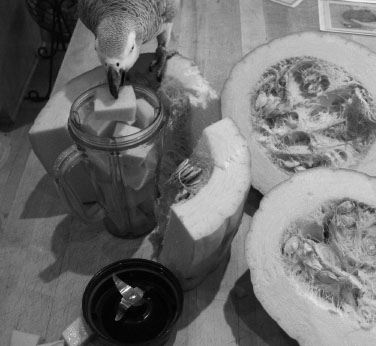
Add about ½ cup of water to the pumpkin chunks, and 1 tablespoon of salt. Blend until most of the chunks are pureed. You don’t need to be perfect, or blend forever, since you are going to filter later, and blending too long will break the DNA strands. But you want something resembling applesauce when you’re done. Your assistant is allowed to taste the results.
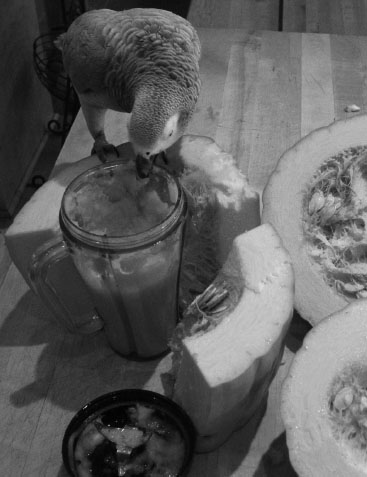
Now add a whole bunch of dishwashing detergent, about ¼ cup. Your assistant is no longer allowed to sample the recipe after this point, but may look at it kind of funny. The detergent and the salt will break open the cell walls of the pumpkin, releasing the DNA into the water.
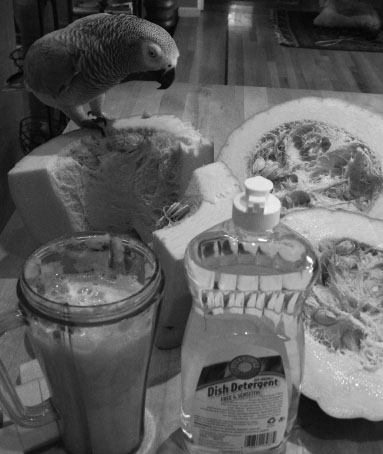
Next, filter the puree using the coffee filter and funnel.
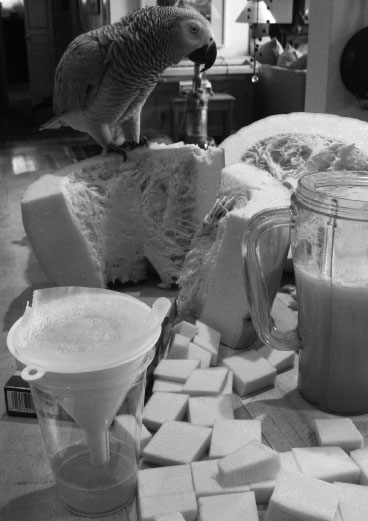
Now it is time to get the liquor out of the freezer. You did remember to put it in there at least an hour ago, right? Your assistant is not allowed to sample the liquids, but may continue eating the raw pumpkin.
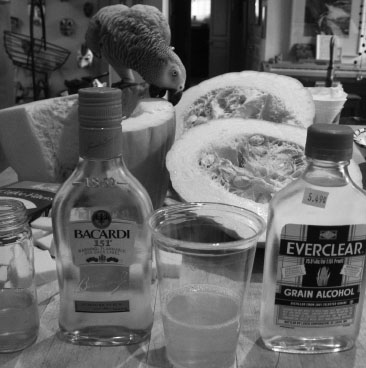
For this part, a shot glass would be appropriate. Too bad I don’t have one; I used a spice jar instead. You could have just used the plastic cup, but a smaller diameter container, such as a test tube, is normally used. Pour some of the filtered pumpkin juice into the container.
Now, tilt the container and very gently pour some of the alcohol slowly so that it forms a layer on top of the juice but does not mix.
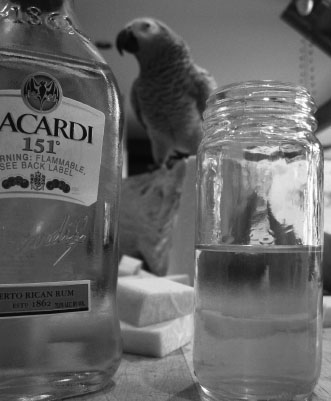
After a few seconds, you will see a ghostly layer of DNA form between the juice and the alcohol. It looks like ghost ectoplasm—a white slimy band of goo floating in the middle of the shot glass or spice jar. This little layer of molecules is the stuff that tells the cells to make a pumpkin and not a banana or a monkey. The pumpkin inherited it from its parent pumpkin plants.
When scientists extract DNA from other plants or animals to study it, they use techniques very similar to what you just did.